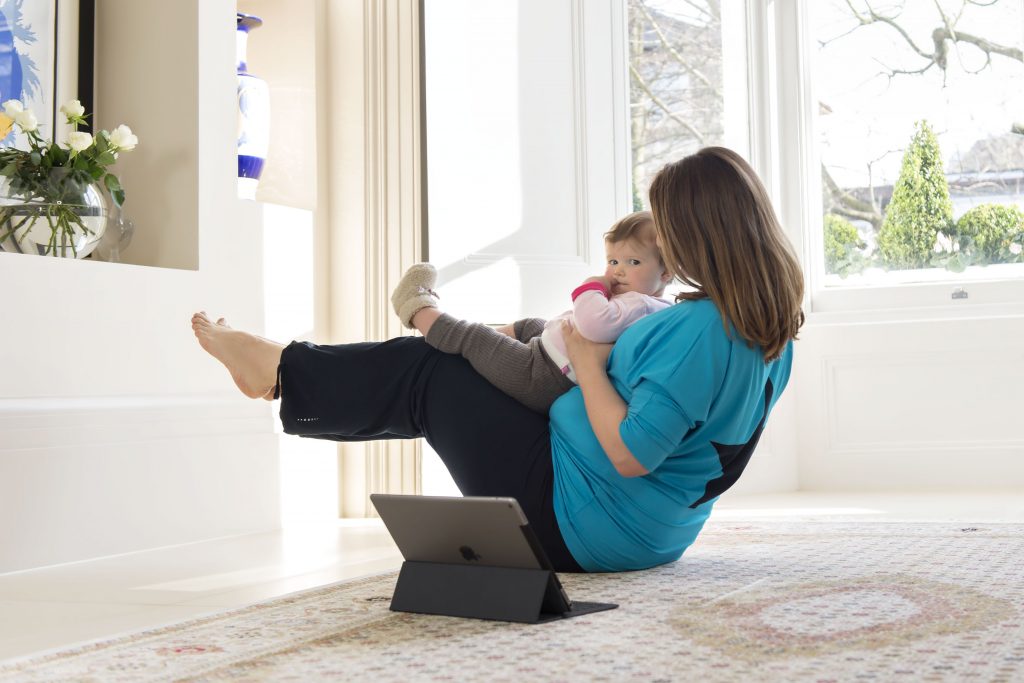Calling all new mummies: Remember to nurture yourself before taking care of others! Here are all the self-care yoga tips you need post baby from Sally Parkes and Kat Farrants.

A New Sort Of Awareness
Pregnant mothers tend to become much more aware of their bodies during pregnancy as this is when the body obviously becomes the home and a source of nourishment for someone else, for another ‘being’.
We have the realization that we have this amazing body that it is capable of creation, and the capacity to nurture a baby until he or she is ready to move in to the world, and we start to take more of an interest in our overall health too.
This is also a time when some mothers learn breathing techniques with the emphasis placed upon how to use them during the birth of their baby and how these techniques can be employed to manage discomfort and stress levels throughout the pregnancy also.
Working With Your Post-Baby Body
This is all positive and certainly a move in the right direction with regards to pre-natal care, but after pregnancy, when the new mother needs the most help to recover, the postnatal care options are often lacking.
Women will realise that their body isn’t quite the same and that their regular exercise training and practicing yoga as they did pre-baby just doesn’t quite feel right. In order to empower herself, the mother really needs to know exactly how her body has changed and how she can respectfully work with her new body, rather than perceiving it as a project that needs ‘fixing’.
This is especially true if she has had a C-section or experienced other birth trauma, as there is a deep healing that needs to take place before a progressive movement routine can be undertaken.
Easy Ways To Incorporate Movement
The most effective way to introduce appropriate movement back in to the daily routine without causing damage, is by working through very short sequences that can be can fitted in to a five to ten minute slot and that can be done easily at home whilst your baby takes a nap or plays. And if you feel guilty about taking this time for yourself, remember that you have to look after yourself to look after others.
Try these simple post-natal recovery yoga postures at home to begin gently integrating movement back in to your daily routine ….
Table Stretch
This is a great way to stretch out achy shoulders and back. Place the hands on the edge of a table or window sill and lower the torso so it is parallel to the floor, and the hips are over the ankles, so body is at a right angle. Hold for ten long deep breaths. This will give a wonderful stretch for the spine, hamstrings and calf muscles too.
Shoulder Roll
Throughout the day, practice standing upright with the spine in a neutral alignment and repetitively roll the shoulders down away from the ears, whilst gently drawing the tummy in towards the spine. This is especially useful to do when walking with the buggy/stroller as this is often when you are looking down at your baby and are not thinking about your posture. This is however the perfect time to reset the posture and by doing so you will feel more mentally positive as you walk in the fresh air with your precious baby.
Abdominal Activation
From around eight weeks post-natal the mother can start to work a bit more directly on the abdominal area. It is likely that the abdominal muscles themselves will still be a little separated at this point so this area should be trained as a unit involving all the surrounding muscle groups as opposed to isolating certain areas of the abdomen, so it is more functional to the mother’s day to day work. Effective movements include:
- Kneeling Abdominal Activation: Kneel on the hands and knees in a box position and ensure a neutral alignment of the spine so excess pressure to the lumbar region is minimised. Breathe in fully before exhaling deeply whilst drawing the abdomen in towards to spine so the entire abdominal area gently contracts. Relax on the inhale. Repeat this ten times.
- Sitting Abdominal Activation Sit in a chair without back support (so your back and abdomen have to work harder to support you). Ensure your back is straight and your feet are on the ground. Take a deep exhale and at the same time raise one foot off the ground. The challenge is to keep the torso completely still whilst the foot is off the ground. Hold on the inhale and relax the leg as you exhale. Repeat twenty times, alternating legs.
It is worth noting that initially you may find that you are able to contract the abdominal muscles only very slightly if at all, but by setting the intention through regular practice, you will stimulate the muscle memory and the muscle fibres will slowly begin to activate again.
Yoga Asana And Movements To Avoid
Deep spinal twists such as Revolved Triangle and Lord of the Fishes. Abdominal Curls and anything that puts pressure on the abdomen including High Plank and Four Limbed Staff Pose. Deep extension of the spine such as Upward Facing Dog and all other back bends should also be avoided as all these movements may hinder healing of any scar tissue and place undue pressure on the lumbar region.
Yoga Videos For New Mummies
The trick to resuming (or starting) your yoga practice is to be gentle, persistent and loving. As with so many things in life, little and often is the best approach rather than trying to smash out a huge class all at once.
This is where Sally’s Post-Natal Series is so helpful. Every class in this series is designed to nurture and restore your post-baby body and help you feel better, calmer, more in control.
And the best bit? You can do it all from home! Baby’s napping? What better way to spend that time than devoting it to renewing yourself? Okay, we know that not all babies nap when you want them to, but that’s precisely the point. With Sally’s 20 minute online classes, you can try to fit in a yoga session whenever it’s convenient. And hopefully you will build up to do a little every day.
>>Find Sally’s Post-Natal Yoga Videos Here>>

Sally Parkes BSc runs Pregnancy and Postnatal Yoga Teacher Training and is a teacher for movementformodernlife.com

Kat Farrants is the founder and CEO of movementformodernlife.com





Leave a Reply